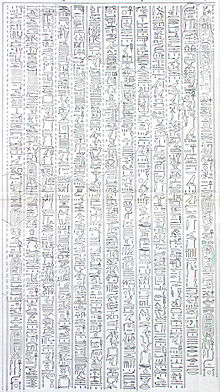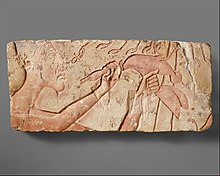Aten
Not long after his death, one of Akhenaten's Eighteenth Dynasty successors, Tutankhamun, reopened the state temples to other Egyptian gods and re-positioned Amun as the pre-eminent solar deity.
[9] Aten was extensively worshipped as a solar deity during the reign of Amenhotep III where it was depicted as a falcon-headed god like Ra.
"[16] Akhenaten represented himself as the son of Aten, mirroring many of his predecessors' claims of divine birth and their positions as the embodiment of Horus.
[3] Aten is both a unique deity and a continuation of the traditional idea of a sun-god in ancient Egyptian religion, deriving a lot of the concepts of power and representation from the earlier solar deities like Ra, but building on top of the power Ra and many of his contemporaries represents.
[20] However, these were typically replaced by functionally equivalent representations of Akhenaten and his family venerating the Aten and receiving the ankh, the breath of life, from him.
[22] A common scene in carved depictions of Akhenaten giving offering to Aten has him consecrating the sacrificed goods with a royal scepter.
Therefore, he did not have physical representations that other traditional ancient Egyptian gods had, instead represented via the sun disc and reaching rays of light tipped with human-like hands.
Thus the inscriptions of scenes of gods carved in stone previously depicted animals and human forms instead showed the Aten as an orb above with life-giving rays stretching toward the royal figure.
Balustrades depict Akhenaten and the royal family embracing the rays of the Aten flanked stairwells, ramps, and altars.
[29] Inscriptions in tombs and temples during the Amarna Period often gave Aten a royal titulary enclosed in a double cartouche.
[32] Ra-Horus, more usually referred to as Ra-Horakhty (Ra who is Horus of the two horizons), is a synthesis of two other gods, both of which are attested from very early on in ancient Egyptian religious practice.
During the Amarna Period, this synthesis was seen as the invisible source of energy of the sun god, of which the visible manifestation was the Aten, the solar disk.
The real change, as some see it, was the apparent abandonment of all other gods on the state level, especially Amun-Ra, prohibition of idolatry, and the debatable introduction of quasi-monotheism by Akhenaten.
After the death of Akhenaten, Tutankhamun reinstated the cult of Amun, and the ban on the state worship of non-Atenism deities was lifted in favor of a return to the traditional ancient Egyptian pantheon.
When Tutankhamun came into power, his religious reign was one of tolerance, with the major difference being that the Aten was no longer the only god worshiped within official, state capacity.
[3] Tutankhamun made efforts to rebuild the state temples that were destroyed during Akhenaten's reign and reinstate the traditional pantheon of gods.





